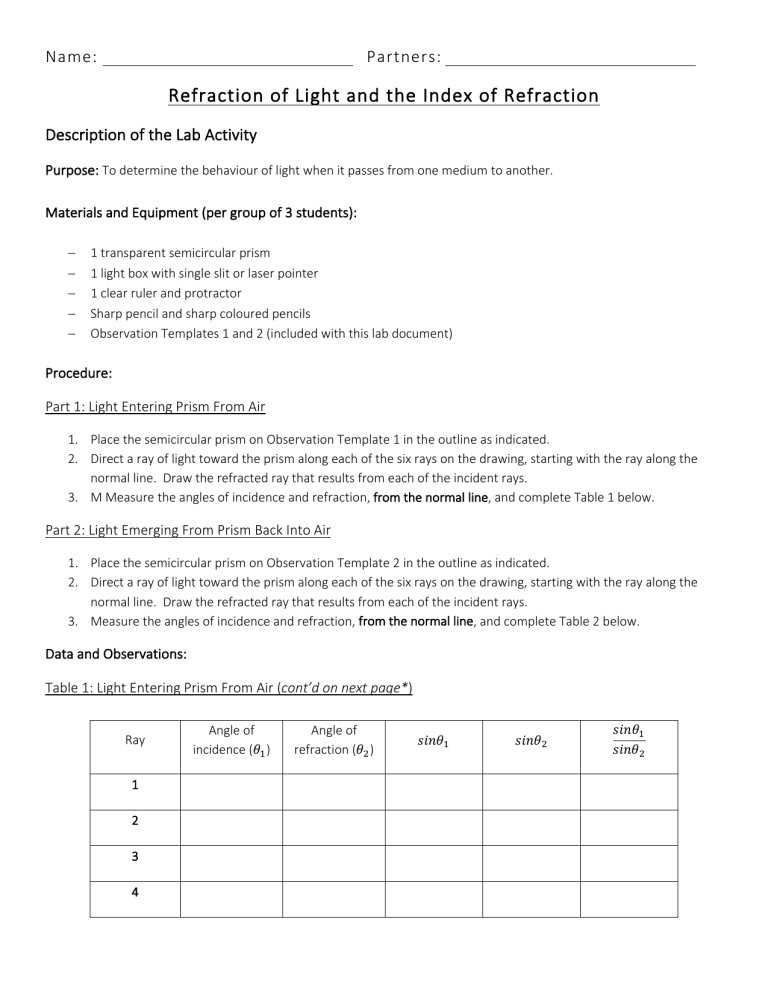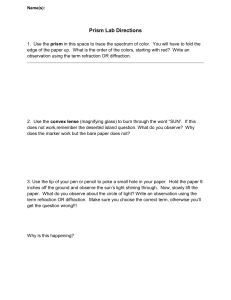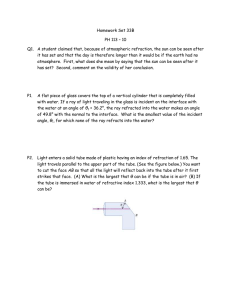
Name: Partners: Refraction of Light and the Index of Refraction Description of the Lab Activity Purpose: To determine the behaviour of light when it passes from one medium to another. Materials and Equipment (per group of 3 students): - 1 transparent semicircular prism 1 light box with single slit or laser pointer 1 clear ruler and protractor Sharp pencil and sharp coloured pencils Observation Templates 1 and 2 (included with this lab document) Procedure: Part 1: Light Entering Prism From Air 1. Place the semicircular prism on Observation Template 1 in the outline as indicated. 2. Direct a ray of light toward the prism along each of the six rays on the drawing, starting with the ray along the normal line. Draw the refracted ray that results from each of the incident rays. 3. M Measure the angles of incidence and refraction, from the normal line, and complete Table 1 below. Part 2: Light Emerging From Prism Back Into Air 1. Place the semicircular prism on Observation Template 2 in the outline as indicated. 2. Direct a ray of light toward the prism along each of the six rays on the drawing, starting with the ray along the normal line. Draw the refracted ray that results from each of the incident rays. 3. Measure the angles of incidence and refraction, from the normal line, and complete Table 2 below. Data and Observations: Table 1: Light Entering Prism From Air (cont’d on next page*) Ray 1 2 3 4 Angle of incidence (𝜃! ) Angle of refraction (𝜃" ) 𝑠𝑖𝑛𝜃! 𝑠𝑖𝑛𝜃" 𝑠𝑖𝑛𝜃! 𝑠𝑖𝑛𝜃" 5 6 *N.B. It is very bad practice to split a data table across two pages. Do as Mr. Gordon says, not as he does. 😊 Table 2: Light Emerging From Prism Back Into Air Ray Angle of incidence (𝜃! ) Angle of refraction (𝜃" ) 1 2 3 4 5 6 Notes, Extra Observations, or Calculations 𝑠𝑖𝑛𝜃! 𝑠𝑖𝑛𝜃" 𝑠𝑖𝑛𝜃! 𝑠𝑖𝑛𝜃" Analysis Questions 1. In both cases, what happened to the ray of light which traveled incident along the normal line (i.e. 𝜃! = 0°)? 2. What do you notice about the values of "#$%! 3. What do you notice about the values of "#$%! "#$%" "#$%" in Part 1? in Part 2? "#$% 4. Is there any special relationship between "#$%! from Parts 1 and 2? Think carefully about the subscripts, and " the medium for which the ray was incident and in which it was refracted for Parts 1 and 2. 5. Table 3 below lists the indices of refraction for four common transparent media used to make prisms. Which is the most likely material of the prism you used in this lab? Table 3: Indices of Refraction for Solid Transparent Media Medium Acrylic Crown Glass Index of Refraction 1.47 1.54 Medium Polystyrene Flint Glass Index of Refraction 1.61 1.68 Observation Template 1 Part 1: Light Passing from Air into the Prism (1) Place the prism inside the semicircle that best corresponds to its size, with the flat sides aligned. (2) Direct the light toward the flat surface of the prism from the air. (3) Mark the points where the light leaves the prism, then remove the prism to draw and label the refracted rays. Measure and record the angles incidence and of refraction. Observation Template 2 Part 2: Light Passing from the Prism into Air (1) Place the prism inside the semicircle that best corresponds to its size, with the flat sides aligned. (2) Direct the light toward the center of the flat surface of the prism, through the curved surface. (3) Mark the points where the light leaves the prism, then remove the prism to draw and label the refracted rays. Measure and record the angles of incidence and of refraction.



